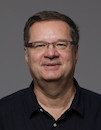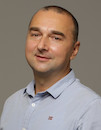Analog and Mixed Signal Processing
Data is displayed for academic year: 2023./2024.
Lecturers
Exercises
Laboratory exercises
Course Description
Real and causal signal spectra; Ideal transmission; Linear and nonlinear distortion; Current Feedback OPAmps; Transconductance OPAmps; Signal and Impedance transformation Circuits; Inductance Simulations; Nonlinear circuits; Comparators; Limiters; Nonlinear Feedback; Filters; Classification; Amplitude, Phase and Group Delay; Approximations; Butterworth; Chebyshev; Cauer; Linear Phase; Passive Filters; Active-RC filters; High-order Filters; Sensitivities; Selective and Coupled amplifiers; Analog Switches and Multiplexers, Models, Errors, Crosstalk, SC Circuits for Signal Processing; Filters, Transducers, Modulators; PLL, AD, DA conversion, Sigma-Delta Converters, VLSI Signal Processing Circuits CAD and CAA programs.
Study Programmes
University graduate
[FER3-HR] Audio Technologies and Electroacoustics - profile
Elective Courses
(2. semester)
[FER3-HR] Communication and Space Technologies - profile
Elective Courses
(2. semester)
[FER3-HR] Computational Modelling in Engineering - profile
Elective Courses
(2. semester)
[FER3-HR] Computer Engineering - profile
Elective Courses
(2. semester)
[FER3-HR] Computer Science - profile
Elective Courses
(2. semester)
[FER3-HR] Control Systems and Robotics - profile
Elective Courses
(2. semester)
[FER3-HR] Data Science - profile
Elective Courses
(2. semester)
[FER3-HR] Electrical Power Engineering - profile
Elective Courses
(2. semester)
[FER3-HR] Electric Machines, Drives and Automation - profile
Elective Courses
(2. semester)
[FER3-HR] Electronic and Computer Engineering - profile
(2. semester)
[FER3-HR] Electronics - profile
Elective Courses
(2. semester)
Elective Courses of the Profile
(2. semester)
[FER3-HR] Information and Communication Engineering - profile
Elective Courses
(2. semester)
[FER3-HR] Network Science - profile
Elective Courses
(2. semester)
[FER3-HR] Software Engineering and Information Systems - profile
Elective Courses
(2. semester)
Learning Outcomes
- Explain the concept of mixed-signal processing and give examples of mixed signal processing systems
- Identify static and dynamic limitations of operational amplifiers
- Analyze and realize linear and nonlinear circuits with operational amplifiers
- Define transfer properties of filter circuits according to given specifications.
- Design and realize passive and active electrical filters.
- Apply optimal components and configurations for realization of signal processing circuits.
- Use SC components in discrete and analog signal processing.
- Apply CAD and CAA programs for realization procedure of circuits.
Forms of Teaching
Lectures
Lectures are given 4 hours per week in the classroom.
ExercisesExercises are given as part of the lecture 1 hour per week in the classroom.
Independent assignmentsStudents will complete 1 homework assignment as part of self work.
LaboratoryLaboratory exercises are held in two cycles of 4 hours per cycles in the department laboratory.
Grading Method
| Continuous Assessment | Exam | |||||
|---|---|---|---|---|---|---|
| Type | Threshold | Percent of Grade | Threshold | Percent of Grade | ||
| Laboratory Exercises | 50 % | 10 % | 50 % | 10 % | ||
| Homeworks | 50 % | 10 % | 50 % | 10 % | ||
| Mid Term Exam: Written | 0 % | 30 % | 0 % | |||
| Final Exam: Written | 0 % | 30 % | ||||
| Final Exam: Oral | 20 % | |||||
| Exam: Written | 50 % | 60 % | ||||
| Exam: Oral | 20 % | |||||
Comment:
Any changes in the method of assessment will be announced at the first lecture. To pass the exam, it is necessary to do all the laboratory exercises and get a minimum grade of 2 on the oral exam.
Week by Week Schedule
- Spectra of real and causal signals, Ideal transmission, linear and nonlinear distortion
- Classification, Transfer function, Amplitude, phase and group delay, Filter approximations
- Passive RC and RLC filters, Active RC Filters, Filter synthesis
- Signal-flow graphs, Memristors, Power-line filters
- Filters with transconductance amplifiers, Current feedback filters, Fully balanced filters, High-order filters
- Signal and impedance transformation circuits, Inductance simulations, Complex filters, Polyphase filters
- SC filters, SC transducers, SC modulators
- Midterm exam
- Analog switches, charge injection, Sample and hold circuits
- Nonlinear circuits, comparators, limiters, Nonlinear feedback
- Advanced DAC and ADC topologies
- Advanced DAC and ADC topologies
- Advanced DAC and ADC topologies
- Data acqusition systems
- Final exam
Literature
(.), G. S. Moschytz. Analog Circuit Theory and Filter Design in the Digital World - With an Introduction to the Morphological Method for Creative Solutions and Design, Springer Nature Switzerland AG 2019, ISBN 978-3-030-00095-0,
(.), R. Schaumann, M. E. Van Valkenburg, Design of Analog Filters, Oxford Univ Press 2001.,
(.), D. Meador Delmar. Analog Signal Processing, Thomson Learning 2002.,
(.), E. S. Sinencio, A. G. Andreu. Low Voltage, Low Power Integrated Circuits and Systems, IEEE Press 1998.,
(.), S. Franco. Design With Operational Amplifiers and Analog Integrated Circuits, McGraw Hill 2002.,
(.), 1. R. Pallas-Areny, J. G. Webster. Analog Signal Processing, Wiley Interscience 1999.,
(.), 2. Ron Mancini, Op Amps For Everyone – Design Reference, Texas Instruments, August 2002.,
(.), 3. Neven Mijat, Električni filtri, FER Zagreb, 2001.,
For students
General
ID 222460
Summer semester
5 ECTS
L1 English Level
L1 e-Learning
45 Lectures
0 Seminar
12 Exercises
6 Laboratory exercises
0 Project laboratory
0 Physical education excercises
Grading System
90 Excellent
75 Very Good
65 Good
50 Sufficient


 Pristupačnost
Pristupačnost
